
Most Visited
Rats In Your Home
Drain Flies
Why Drains Block
Internal Venting
Who`s Drain Is It ?
Drain Surveys
No-Dig Repairs
Drain Location
Drain Rods Stuck
Find A Contractor
Drain Pipe Work
Clay Drain Pipes
Plastic Pipe Work
Pitch Fibre Pipes
Cast Iron Pipes
Concrete Pipes
Drainage Parts
Drain Gullies
Dropshafts
Interceptor Traps
Soil Vent Pipes
Anti-Flood Valves
Manholes
Drain Repairs
Excavations
Drain Lining
Patch Lining
Pipe Bursting
Re-Rounding
Drainage
Investigations
Drain Surveys
Sonar Tracing
Last updated 7 January, 2014
draindmain.com > site map > drainage gullies
Drainage Gullies
The gully traps also intercept silt and debris from a roof or a hard standing preventing it from entering the main line system, due to this and the build up of grease and fat that can occur in kitchen waste gullies a certain amount of maintenance can be required to prevent them from blocking. This can be as easy as lifting the gully grid or grating and cleaning it out by hand wearing a suitable pair of gloves. The above advise is sound when dealing with your domestic property, if you are attempting to clean out gullies on buildings in public places such as schools and colleges or in parks and town centers there is always the risk of injury from sharps, needles and syringes. In these circumstances the appropriate safety gloves and equipment should be worn.
All gullies are subject to defects such as root ingress because by nature they are installed just below ground level, for the same reason they are prone to fracturing from vehicle movement As the gully is adjacent to the property it would usually be sat on back fill material rising from the house foundations upwards, even if the gully has been bedded on concrete or brickwork any settlement to poorly compacted back fill will
For these reasons gullies can be blocked for months and years but the system will not overflow because of the gap that has opened between the two sections allowing water to escape to the sub-soil area as shown in the image on the right, subsidence to properties can often be put down to gullies, particularly those at the corners of the Roddable Gullies
These are gullies with an internal cap or plate that can be removed so that you can by-pass the trap and access the outlet pipe, this makes clearing a blockage or surveying a system much easier. These are not a new phenomenon by any means and they featured heavily in early trade catalogues but for some reason, probably cost they are seldom seen on domestic properties unless installed in the last 20 years. The most common defects found on these types of gullies are usually down to human error, the removable cap will be missing allowing a direct vent from the drainage system at ground level or somebody will go to the trouble of installing a roddable gully and then they will fit the down spout tight onto the gully grid so that it can not be removed for maintenance purposes.
|
||||||||||||||||||
| related pages - | drainage bends |
| drainage junctions | |
| drainage dropshafts | |
| find a contractor | |
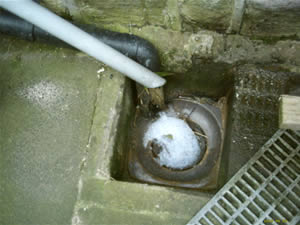 Drain gullies or grids as most people describe them are the ground level drains that your waste or storm water pipes discharge into, they come in numerous shapes and sizes and can be a single unit or two and three piece affairs constructed in clay, plastic, cast iron or concrete. The basic idea of a gully is that you have a trapped receptacle at surface level that waste or storm water can pass through easily but gases, odours and rodents from the drainage and sewer system can not pass back the other way.
Drain gullies or grids as most people describe them are the ground level drains that your waste or storm water pipes discharge into, they come in numerous shapes and sizes and can be a single unit or two and three piece affairs constructed in clay, plastic, cast iron or concrete. The basic idea of a gully is that you have a trapped receptacle at surface level that waste or storm water can pass through easily but gases, odours and rodents from the drainage and sewer system can not pass back the other way.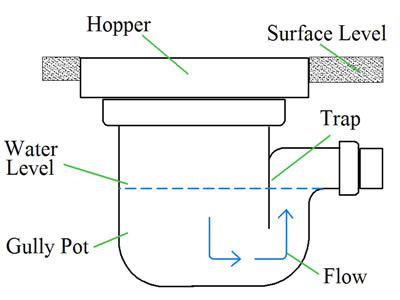 The image to the right shows a salt glazed gully pot with a square hopper top at ground level, the hopper top has a spigot base that sits inside the collar at the top of the gully though the two were seldom jointed. Some of the older gullies have a large enough trap and outlet to carefully pass a push rod camera around, whilst gullies found in areas such as Merseyside have what we call a pillar box trap which are very square and tight and can restrict a mechanical rod or jetting hose.
The image to the right shows a salt glazed gully pot with a square hopper top at ground level, the hopper top has a spigot base that sits inside the collar at the top of the gully though the two were seldom jointed. Some of the older gullies have a large enough trap and outlet to carefully pass a push rod camera around, whilst gullies found in areas such as Merseyside have what we call a pillar box trap which are very square and tight and can restrict a mechanical rod or jetting hose.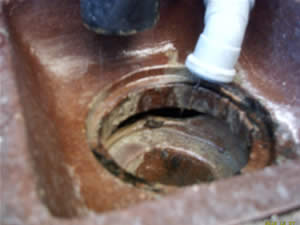
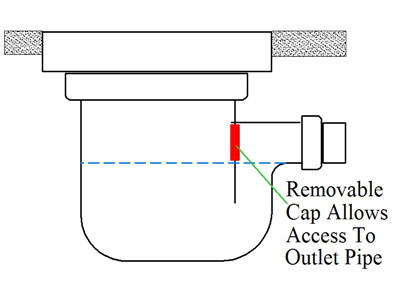
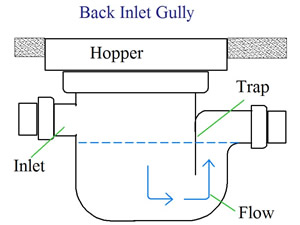 Back Inlet Gullies
Back Inlet Gullies 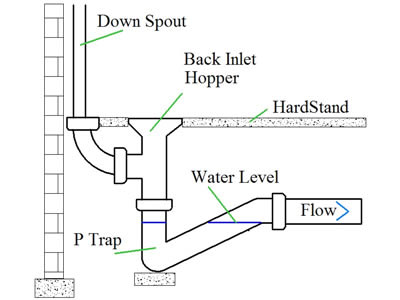 An alternative to the gully pot is the P-Trap and hopper top, as the image to the right shows these are a two piece affair found on both storm and foul waste gullies. They are less accessible than gully pots with regard to being cleaned out but because they are circular in shape and the same diameter as the outlet pipe they can be easily plunged, though this does tend to mean that you push the silt and debris or grease and fat into the main line system.
An alternative to the gully pot is the P-Trap and hopper top, as the image to the right shows these are a two piece affair found on both storm and foul waste gullies. They are less accessible than gully pots with regard to being cleaned out but because they are circular in shape and the same diameter as the outlet pipe they can be easily plunged, though this does tend to mean that you push the silt and debris or grease and fat into the main line system. 

